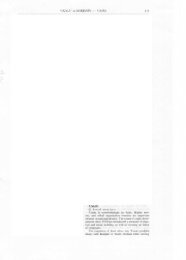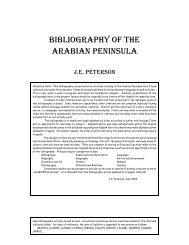THE ARABIAN PENINSULA IN MODERN TIMES: A - JEPeterson.net
THE ARABIAN PENINSULA IN MODERN TIMES: A - JEPeterson.net
THE ARABIAN PENINSULA IN MODERN TIMES: A - JEPeterson.net
You also want an ePaper? Increase the reach of your titles
YUMPU automatically turns print PDFs into web optimized ePapers that Google loves.
Economic, Social, and Cultural History<br />
Economic History. An encouraging sign of diversification and intensification of efforts is the<br />
growing literature on economic, social, and cultural history, to a degree unthinkable before<br />
1990. Whereas the story of oil exploration was a prominent feature of earlier writings, post‐<br />
1990 literature has produced Anthony Cave Brown’s sweeping history of ARAMCO (the Arabian<br />
American Oil Company) while Robert Vitalis has challenged conventional history of ARAMCO<br />
and the American impact on Saudi Arabia. 45<br />
The Peninsula has experienced two distinct types of economic development or change. The<br />
six members of the GCC have all experienced high income from oil exports (and some, more<br />
latterly, from gas exports). Their state‐directed income distribution, small populations and lack<br />
of other natural resources have driven what some have termed rentier economies that benefit<br />
certain sectors of the population more than others, as Rayed Krimly and Steffen Hertog<br />
demonstrate. The other type of economy is that of Yemen, similar to many Third World<br />
countries and characterized by limited and dwindling oil production, exploding population,<br />
persistent poverty, and growing water scarcity, as Ali al‐Hagari has outlined. 46<br />
A key element of economic history regarding the Peninsula has been that of trade. Rather<br />
than constituting a destination, the Peninsula served as a focal point for transit from East to<br />
West and West to East. Overland routes have been of key importance for millennia but Arabia<br />
also boasts a variety of ports with long and storied histories, as Mohamed El Amrousi and<br />
Willem Floor delineate. More attention has been paid to the Red Sea and Gulf of Aden, as<br />
shown in the works by Colette Dubois, Michel Tuchscherer, Roxani Margariti, Hasan Shihab,<br />
C.G. Brower, Giancarlo Casale, Guido Steinberg, and André Raymond. 47<br />
(Wilby, Norwich, UK: Michael Russell, 1994); Cliff Lord and David Birtles, The Armed Forces of Aden 1839-1967<br />
(Solihull, West Midlands, UK: Helion, 2000); Frank Edwards, The Gaysh: A History of the Aden Protectorate<br />
Levies 1927-61 and the Federal Regular Army of South Arabia 1963-67 (Solihull, UK: Helion, 2004); Jonathan<br />
Walker, Aden Insurgency: The Savage War in South Arabia 1962-1967 (Staplehurst, UK: Spellmount, 2005); Tom<br />
Walcot, “The Trucial Oman Scouts 1955 to 1971: An Overview,” Asian Affairs (London), Vol. 37, No. 1 (March<br />
2006), pp. 1730; J.E. Peterson, Oman’s Insurgencies (London: Saqi, 2007).<br />
45. Anthony Cave Brown, Oil, God and Gold: The Story of ARAMCO and the Saudi Kings (Boston: Houghton<br />
Mifflin, 1999); Robert Vitalis, America’s Kingdom: Mythmaking on the Saudi Oil Frontier (Stanford: Stanford<br />
University Press, 2006); ibid., “Aramco World: Business and Culture on the Arabian Oil Frontier,” in Karen<br />
Merrill, ed., The Modern Worlds of Business and Industry: Cultures, Technology, Labor (Turnhout, Belgium:<br />
Brepols, 1999), pp. 3-25; ibid., “Aramco World: Business and Culture on the Arabian Oil Frontier,” in Robert<br />
Vitalis and Madawi al-Rasheed, eds., Counter-Narratives: History, Contemporary Society, and Politics in Saudi<br />
Arabia and Yemen (New York: Palgrave, 2004), pp. 151-182.<br />
46. Ali Saleh al-Hagari “A Comparative Study of the Economies of the Yemen Arab Republic and the People’s<br />
Democratic Republic of Yemen (1970-1988)” (Ph.D. dissertation, University of Nebraska-Lincoln, 1992); Rayed<br />
Khalid Krimly, “The Political Economy of Rentier States: A Case Study of Saudi Arabia in the Oil Era, 1950-1990”<br />
(Ph.D. dissertation, George Washington University, 1993); Steffen Hertog, “Segmented Clientalism: The Politics of<br />
Economic Reforms in Saudi Arabia,” Ph.D. thesis, St. Antony’s College, Oxford, 2006); ibid.,“Shaping the Saudi<br />
State: Human Agency’s Shifting Role in Rentier-State Formation,” International Journal of Middle East Studies,<br />
Vol. 39, No. 4 (November 2007), pp. 539-563.<br />
47. Hassan Saleh Shihab, “Aden in Pre-Turkish Times (1232-1538): The Arabian Entrepot of the Western Asian<br />
Seas,” in Frank, Broeze, ed., Gateways of Asia: Port Cities of Asia in the 13th-20th Centuries (London: Kegan Paul<br />
International, 1997), pp. 17-32; Mohamed Mohamed El Amrousi, “Beyond Muslim Space: Jeddah, Muscat, Aden<br />
and Port Said” (Ph.D. dissertation, University of California, Los Angeles, 2001); André Raymond, “A Divided Sea:<br />
14







